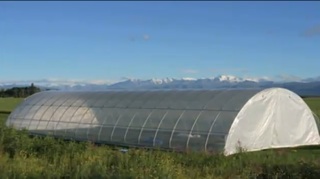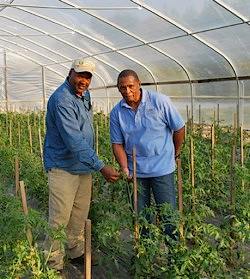 Farmers, like Earl and Clarisse Snell of Alabama, can still grow summer squash and tomatoes as if it were summer, thanks to their new high tunnel built with financial assistance from the US government. Also called hoop houses, seasonal high tunnels look a lot like greenhouses but require no artificial energy source—all they need is natural daylight. With their natural pest controlled environment, farmers across the country are now able to sell organic, locally grown produce throughout the year in states as cold as Minnesota, Wisconsin and even Alaska.
Farmers, like Earl and Clarisse Snell of Alabama, can still grow summer squash and tomatoes as if it were summer, thanks to their new high tunnel built with financial assistance from the US government. Also called hoop houses, seasonal high tunnels look a lot like greenhouses but require no artificial energy source—all they need is natural daylight. With their natural pest controlled environment, farmers across the country are now able to sell organic, locally grown produce throughout the year in states as cold as Minnesota, Wisconsin and even Alaska.
$13 million from USDA’s Natural Resources Conservation Service (NRCS) has gone to more than 2,400 farmers in 43 states to help pay for the low-tech seasonal high tunnels.
NRCS provided the assistance as part of a pilot project to determine how effective high tunnels are in conserving water, reducing pesticide use, maintaining soil nutrients, and increasing crop yields. The pilot is offered under the Know your Farmer, Know your Food initiative, a USDA effort to connect farmers and consumers, strengthen local and regional food production, increase the use of sustainable agricultural practices, and promote local, fresh food.
 Mr. Snell is pleased with the results. The seasonal high tunnel is saving him money on pesticides and allowing him to grow more food organically. With the help of the controlled environment of the high tunnel, he expects to harvest several types of fruits or vegetables 12 months of the year. In addition to tomatoes and squash, the Snells envision growing peas, butterbeans, corn, watermelons, cantaloupes, flowers, and herbs.
Mr. Snell is pleased with the results. The seasonal high tunnel is saving him money on pesticides and allowing him to grow more food organically. With the help of the controlled environment of the high tunnel, he expects to harvest several types of fruits or vegetables 12 months of the year. In addition to tomatoes and squash, the Snells envision growing peas, butterbeans, corn, watermelons, cantaloupes, flowers, and herbs.
Winter farmers markets are becoming more popular — representing 14 percent of the total number operating in the US. And, with the demand for local, organic food increasing, winter markets are ‘cropping’ up in cold states too, like New York, which has a whopping 153 markets happening between November and March.
The hoop house assistance program was launched from the White House vegetable garden in December 2009, where small hoops were built over newly planted gardens for herbs and greens. See more about how farmers and consumers are benefitting from the financial in the USDA video below:



















